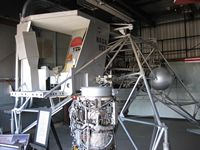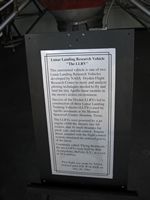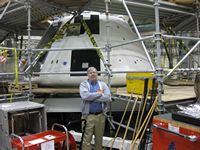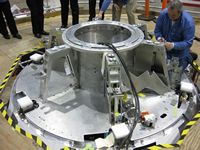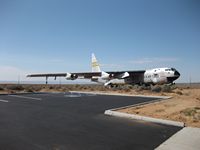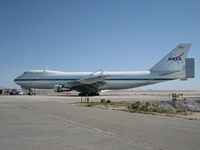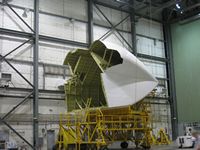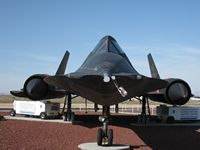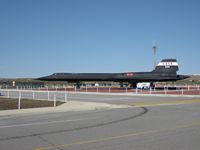As noted on the official website of the Space Elevator Games, we’re now down to four teams; the Kansas City Space Pirates, LaserMotive, USST and the University of Alberta. KCSP, LaserMotive and USST have all met all hurdles and are in. The Alberta team has to convince both Spaceward and NASA that they are ready to go…
Right angle turns in mid-air
Have I said how cool this place is? So much advanced research going on here – it’s been one of the issues in getting the Games working here – coordinating the Games schedules with everything else going on at this location.
 I was writing a blog post today when another sonic boom occurred – there have been enough of these that they don’t make me jump anymore. But I still go outside after I hear one and hope that I can see something cool. Today I most definitely did. The picture isn’t great, as the contrail was already starting to dissipate by the time I got my camera, but darned if, at the bottom of the photo, that doesn’t look a 90 degree turn in mid-air…
I was writing a blog post today when another sonic boom occurred – there have been enough of these that they don’t make me jump anymore. But I still go outside after I hear one and hope that I can see something cool. Today I most definitely did. The picture isn’t great, as the contrail was already starting to dissipate by the time I got my camera, but darned if, at the bottom of the photo, that doesn’t look a 90 degree turn in mid-air…
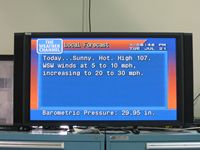 And not only is this place, cool, it’s hot. Take a look at the screen shot I captured today of the Weather Channel. Of course it is the middle of July and we are in the Mojave desert…
And not only is this place, cool, it’s hot. Take a look at the screen shot I captured today of the Weather Channel. Of course it is the middle of July and we are in the Mojave desert…
(Click on the picture thumbnails to see a larger version of the picture)
USST is here…

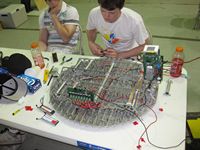 USST is now here in force – they brought a whole army with them this time – I’m going to see if I can get a group shot of them sometime (part of them are out on the lakebed right now doing laser testing).
USST is now here in force – they brought a whole army with them this time – I’m going to see if I can get a group shot of them sometime (part of them are out on the lakebed right now doing laser testing).
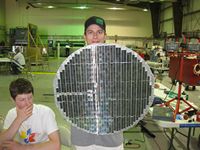 When they arrived late for the first round of testing, no one was very worried that they wouldn’t eventually be ready. They did get a lot done in the short time they were onsite and were provisionally cleared to compete. And, we all know that they are a force to reckoned with in these Games, having had the best performing climbers in the 3 previous Games. They are also the only team with a successful laser climb to the top of the competition tether under their belt – and they did it multiple times in a row.
When they arrived late for the first round of testing, no one was very worried that they wouldn’t eventually be ready. They did get a lot done in the short time they were onsite and were provisionally cleared to compete. And, we all know that they are a force to reckoned with in these Games, having had the best performing climbers in the 3 previous Games. They are also the only team with a successful laser climb to the top of the competition tether under their belt – and they did it multiple times in a row.
Still, its nice to see them here, all loaded for bear as the are. I’ve included several pictures of their partially assembled climber in this post (they are putting it together as I blog).
The topmost picture is of the top of their solar cell array while the second picture is of the bottom of the array. I picked it up – it’s not nearly as heavy as it looks.
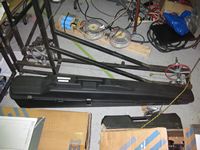 This third picture is my favorite – it’s the case they use to transport part of their climber in. It looks suspiciously like the case I use for my Mossberg 535…
This third picture is my favorite – it’s the case they use to transport part of their climber in. It looks suspiciously like the case I use for my Mossberg 535…
The last picture is of the treadmill that they use for some of their testing. You can see the climbing mechanism of their climber on the right.
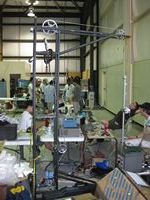 One more USST note; they’ve changed their website – the new location is now http://www.usst.usask.ca/. Because I hadn’t noticed this, I haven’t seen their latest updates including a very good summary of their last testing go-round. It’s really worth a read and lets you know the efforts and issues that these teams have to deal with.
One more USST note; they’ve changed their website – the new location is now http://www.usst.usask.ca/. Because I hadn’t noticed this, I haven’t seen their latest updates including a very good summary of their last testing go-round. It’s really worth a read and lets you know the efforts and issues that these teams have to deal with.
More later…
40th Anniversary of the First Man on the Moon
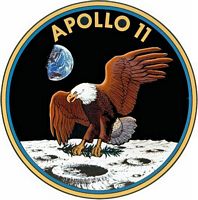 Forty years ago today, Neil Armstrong became the first man to step foot on the moon, or indeed on any astronomical body outside the earth.
Forty years ago today, Neil Armstrong became the first man to step foot on the moon, or indeed on any astronomical body outside the earth.
I remember precisely where I was at that time. I was at my fiance’s home, watching TV with her and her family. They had a black and white TV and OK reception – but it was good enough to see everything I wanted to see.
Much has been made lately about the restored footage of the moon landing – but none of that matters to me (though the responsible party, or perhaps I should say irresponsible party at NASA that allowed the original tapes to disappear deserves to have his/her name(s) listed on the all-time Wall of Shame). I saw it happen when it happened and the magic of the moment has never left me. Near-senior citizen status does have its compensations, I guess.
It’s amazing that this happened 40 years ago. And no one else has done it, only the United States through its NASA arm.
We’ll be back…
Miscellaneous updates – 2
Here is some more Space Elevator miscellany, gleaned from the web over the past several weeks…
The website Next Big Future always has interesting posts and I subscribed to it long ago. This is a posting from this site from last January, talking about Alan Windle’s carbon nanotube ribbons. According to the article, he has created something which has been measured at 9GPa. If true, I sure hope he brings it to this year’s Strong Tether competition (being held at the Space Elevator Conference) – he would be a favorite to win.
This is an article, in French, about the Space Elevator Games and Space elevators, in general. If you parlez the Francais (sorry for my slaughtered translation), enjoy…
And then we have another article about a Space Elevator, this time in Vietnamese…
 One of my favorite sites, io9, has a posting about a new book with a Space Elevator as a backdrop, The Third Claw of God. This is the second in the series of Andrea Cort novels and io9’s review of the book says its a winner. I suppose you can find it at your local bookstore, and it’s available in paperback from Amazon for $7.99. It’s also available for Kindle and, as I’m lucky to have one, I’ve just downloaded it – I’ll start it on the plane-ride out to California next week. When I’ve finished reading it, I’ll post a review.
One of my favorite sites, io9, has a posting about a new book with a Space Elevator as a backdrop, The Third Claw of God. This is the second in the series of Andrea Cort novels and io9’s review of the book says its a winner. I suppose you can find it at your local bookstore, and it’s available in paperback from Amazon for $7.99. It’s also available for Kindle and, as I’m lucky to have one, I’ve just downloaded it – I’ll start it on the plane-ride out to California next week. When I’ve finished reading it, I’ll post a review.
.
In a recent speech to the Rensselaer Polytechnic Institute class of 2009, Futurist Peter Schwartz spoke of “…ten areas to make a Global Impact, find success” to help create a peaceful, prosperous world by the year 2050. “The final item on Schwartz’s list is discovering new ways to radically lower the cost and environmental impact of space flight, and developing new ways, such as a space elevator, to get into space.” I can only say “Amen” to that…
James Coughtrey has created an alternative world scenario entitled “Vast Worlds“. It’s driven by humans acquiring technology from a derelict alien starship. In this scenario;
The Chinese space elevator was the only one that was actually on the equator. Both the Commonwealth and AMA have theirs off centre for economic reasons. New Inca’s is placed further south to avoid American airspace, America doesn’t cross the equator and Russia doesn’t actually have a space elevator but an assisted floater rocket system.
I haven’t had a chance to review all of this, but it looks quite interesting…
Dave Barry recently opined on the Space Elevator here – most of his jokes about the elevator are a bit dated.
This is an interesting blog post concerning Space Based Solar Power. A constituent attended a congressional briefing by Mark Kirk (he represents the district next to mine) and asked him about his views on SBSP. Congressman Kirk identified one of the issues preventing the widespread use of it; i.e. the cost to orbit. The writer states that we should look at this issue in light of; “…the mass required to produce a kilowatt of electricity (kg/kw) and the total system cost to produce a kilowatt of electricity (cost/kw)“. I think this is correct, but alas, the writer didn’t supply his opinion of what this number should be. I’ve written before about my skepticism about the practicality of SBSP and gave my numbers here.
A related article about Pacific Gas & Electric (PG&E) purchasing electricity created by SBSP is here. Two companies are mentioned, Solaren and Space Energy. As I’ve said before, I’m skeptical if this idea can work – it’s a lot easier to make a website than it is to generate SBSP cost-effectively. I have no issues with the technology – I have serious doubts if we can generate enough electricity (we use so much of it) via SBSP to every make it worthwhile. But if you believe that the idea of SBSP is a good one, I think you absolutely have to support the idea of a Space Elevator – no other technology gives you a chance to get enought stuff into orbit, cost-effectively enough, to perhaps make this idea work.
No, I still haven’t seen the new Star Trek movie, but I’m very interested in seeing the Vulcan Space Elevator made of “…of metallic chunks the size of refrigerators.” Maybe after the Space Elevator Conference is over…
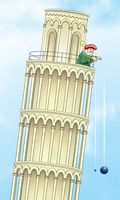 If you’ve ever wondered what would happen if you dropped balls (or other heavy weights) from a Space Elevator, here’s a discussion thread on the question.
If you’ve ever wondered what would happen if you dropped balls (or other heavy weights) from a Space Elevator, here’s a discussion thread on the question.
Enough for now – time to get ready to head out to NASA-Dryden for Round 2 of testing for the upcoming Space Elevator Games…
(Picture thumbnail of Galileo and his balls from here – click on it for a larger version).
The new pulley
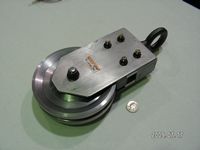 Interrupting my series of “Miscellaneous updates”, I’d like to show you a picture of the new pulley built by NASA. This will replace the one which failed in the last testing round and will, hopefully, prove to be more than capable of handling the load.
Interrupting my series of “Miscellaneous updates”, I’d like to show you a picture of the new pulley built by NASA. This will replace the one which failed in the last testing round and will, hopefully, prove to be more than capable of handling the load.
The next round of testing starts, in earnest, next Tuesday. Some of us are in California already while others (including myself) will shortly be on the way.
This coming week should be a lot of fun. Stay tuned to this blog or the official website of the Space Elevator Games or Twitter to keep up to date.
(Click on the picture thumbnail to see a larger version)
Miscellaneous updates – 1
Lots of Space Elevator items have been posted on the web in the past several weeks, items I’ve neglected to mention as I’ve been concentrating on the upcoming Space Elevator Games and Space Elevator Conference, so today and tomorrow I’ll be doing some ‘summary posting’ of some of these items:
First, of course, is a Status update from the Games themselves, posted on the official website of the Games…
A new “Space Elevator” (of sorts) has made it to the movies. There is a new movie coming out “Percy Jackson & the Olympians: The Lightning Thief” which, incidentally, some Hollywood blogs are all upset about because they say it is a ripoff of the Harry Potter movies. In a trailer for the movie, Percy is shown entering an elevator at the Empire State Building, but the elevator car blasts through the top of the building and all the way to Mount Olympus. We don’t actually see the “Space Elevator” of course…
The idea of an inflatable space elevator has been making the rounds lately. There were several postings about this, one of the more complete ones is here (with some comments on it here). While I haven’t given it a lot of thought, it sounds a bit dicey to me. It will be only 20 kilometers high and supposedly be kept vertical by the use of “stabilizers and gyroscopes” and will withstand the force of hurricanes by “leaning into them”. Supposedly you could also save some rocket fuel by lifting the components up to the top of the tower and then launching them from that point. However, no numbers are given as to how much could be lifted, how often, etc. I wish them success…
Another type of Space Elevator recently proposed was the “Rotating Space Elevator” a method to use centrifigal force to power climbers ascending the structure. This sounds cool, of course, as it’s essentially free power, but I don’t think it’s practical – I don’t think that enough force is generated to lift anything useful. But I will admit I’ve only glanced at this article in a cursory manner and perhaps I’ve missed something. So many Space Elevator concepts, so little time…
During the first round of testing at Dryden, there was a “Press Day” where NASA had local columnists and camera crews come out and visit. I made a presentation to them and then they visited the workshop where teams had set up plus the testing operations out on the lakebed. One of the stories is here, complete with a couple of pictures of the NSS and University of Michigan team climbers.
All for now – more miscellany tomorrow…
Testing, round 2, begins…
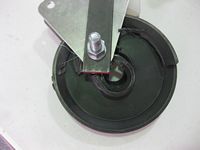 I’m told that at the NASA-Dryden facility, testing begins today on the newly engineered pulley which will be used during the upcoming Space Elevator Games Climber / Power-Beaming competition.
I’m told that at the NASA-Dryden facility, testing begins today on the newly engineered pulley which will be used during the upcoming Space Elevator Games Climber / Power-Beaming competition.
Readers may recall (from my blog and also from the official website of the Games) that the pulley used during the first round of testing failed after much of the testing had been completed. This pulley failure caused the steel cable raceway to shear. It was the only technical failure of the day, however, as everything else seemed to hold up very well.
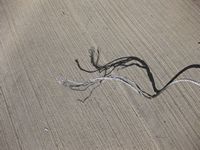 This is preliminary testing of the pulley only as testing with the helicopter and winch will not occur until next week. I’m sure however, NASA will test this pulley every way they can and so we all are confident that the pulley will perform as needed during the second round of testing next week and at the Games.
This is preliminary testing of the pulley only as testing with the helicopter and winch will not occur until next week. I’m sure however, NASA will test this pulley every way they can and so we all are confident that the pulley will perform as needed during the second round of testing next week and at the Games.
This is what testing is for; find those components of the system that fail during normal operations (or beyond) and redesign and/or strengthen them.
Over at the Space Elevator Games Blog, Ben Shelef writes about testing in general. It’s a very good summary of what testing is all about and the limitations with it.
I’ll be out at Dryden next week for the testing and will be blogging and Tweeting onsite.
(Click on either picture thumbnail to see a larger version of the picture)
The 2009 Space Elevator Conference
Sometimes lost amid the hoopla surrounding the upcoming Space Elevator Games is the fact that the 2009 Space Elevator Conference begins in just a few short weeks; from August 13-16 in Redmond, Washington.
This conference is the latest in a series of conferences about Space Elevators which began in September of 2002. Much has changed since that first conference; carbon nanotubes have gone from the lab into the real world (albeit not yet strong enough to make a Space Elevator tether), laser power has increased by leaps and bounds, new books and papers have been written on the subject, the Space Elevator Games have been created, Space-Elevator themed organizations have come into existence in Europe and Japan and the International Space Elevator Consortium (ISEC) has been created.
But the basic premise remains the same; if we can ever build a Space Elevator, it should prove to be a far superior way of delivering cargo (and eventually people) into space. It is far more scalable, much cheaper, much easier on the cargo and environmentally much more friendly than conventional rockets and it has a coolness factor which is absolutely undeniable.
If you’re interested in the concept of a Space Elevator, this upcoming conference is a ‘must-visit’ event. I’ll be there, presenting two papers (one on ISEC and one on Risk Assessment) – and many other presentations are in the works. I hope you are planning on coming too.
There are several ticket plans available, all spelled out on the official website of the conference. Note that early registration is now closed but that if you’re a member of ISEC, you can get a discount to the conference. So, join ISEC, help advance the cause of a Space Elevator, and save some money!
On Friday, August 14th, the Strong Tether competition portion of the Space Elevator Games will be held at the Conference. While the Climber / Power-Beaming portion of the competition is ‘sexier’ and gets more attention, the Strong Tether competition is at least as important to building a Space Elevator (and NASA has donated a prize purse of 2 Million US Dollars to this competition too). This year I’m told that we will have more than one team at the competition with a carbon nanotube tether. As with the Climber / Power-Beaming technology, tether technology is advancing too, and the Space Elevator Games are playing a major role in this. If you want to see engineers do their best to break things, you’ll want to attend this Conference event…
Everything scheduled in this conference is of interest to me, but as President of ISEC, Sunday is especially key. This is the day where the Four Pillars Workshops will be held, dealing with the Technology, Business, Legal and Public Outreach facets of building a Space Elevator. If you want to get involved in a hands-on way with furthering the concept of a Space Elevator, these workshops are a great way to do so. You’ll meet like-minded people, talk with the ISEC Pillar leads and will be able to contribute your thoughts and ideas (and get more involved if you like).
See you in Redmond!
Bryan Laubscher appears on NPR radio
![]() Earlier today, Bryan Laubscher, PhD, astrophysicist, long-time supporter of the concept of a Space Elevator and conference organizer extrordinaire, appeared on NPR Radio. The topic was entrepreneurship and Bryan was talking about developing carbon nanotubes to build a Space Elevator.
Earlier today, Bryan Laubscher, PhD, astrophysicist, long-time supporter of the concept of a Space Elevator and conference organizer extrordinaire, appeared on NPR Radio. The topic was entrepreneurship and Bryan was talking about developing carbon nanotubes to build a Space Elevator.
It’s a short piece but very interesting. Check it out.
NASA Dryden Research Facility
In my last post, I showed some of the aircraft (real and mockups) that are scattered about the Edwards Air Force Base and NASA Dryden Research Facility. But they also have spacecraft they’re working on too – after all, this is NASA. Here are a few more photos and brief explanations:
|
|||
|
|||
|
|||
|
.
(Again, click on any of the picture thumbnails to see a larger version of the picture)
Edwards Air Force Base
Have I said how cool this place is? Just outside the main checkpoint at the Northern entrance sits a B-52. This is a real B-52, flown by NASA and now retired. It was used to lift several prototype aircraft into the air for launch including the X-15 and the X-43a’scram-jet’. The unofficial history of this aircraft can be found here.
Once you get through the parking lot and enter the NASA Dryden facility, you park your car in the centrally located parking lot. Surrounding this lot is a series of aircraft (some real, some mock-ups). The coolest plane, by far, is the SR71 Blackbird, but they are all awesome, especially since you can walk right up to them. Here are a few pictures I took…
|
|||
|
.
Incidentally, there is a Shuttle launch scheduled for July 11th. Lets hope nothing is delayed and they can land fine in Florida – otherwise it might affect the Games.
(You can click on any of these picture thumbnails for a larger version)
The human side of the Games
 Yes the technology is way cool – we’re going to watch Climbers powered by class-4 lasers ascend a kilometer long steel cable, at 5 meters/second no less, held aloft by a helicopter. All of this will happen at the NASA Dryden Research Center located at Edwards Air Force base – and then there is the small matter of the $2Million prize purse too… Who could view all of this and not be awed by the work and technology that has gone into making this happen?
Yes the technology is way cool – we’re going to watch Climbers powered by class-4 lasers ascend a kilometer long steel cable, at 5 meters/second no less, held aloft by a helicopter. All of this will happen at the NASA Dryden Research Center located at Edwards Air Force base – and then there is the small matter of the $2Million prize purse too… Who could view all of this and not be awed by the work and technology that has gone into making this happen?
It takes people to make this all happen and documenting the work, the planning, the disappointments and frustrations, the success stories and all the other human effects and emotions incumbent in these Games is the job of the Chicago video production company Bitter Jester Creative, Inc.
I’ve blogged about these guys before, but think it’s time to mention them again. At the Games Official Website, Ben has a fine post about the people and the project at Bitter Jester.
 They’re such perfectionists – I remember at the last Games they spent so much time setting up the ‘perfect shot’ for the Space Elevator Toy that the Japanese team (E-T-C) brought with them – and it will probably only get a few seconds in the final production (if it’s there at all). They take this same attitude towards everything they’ve been doing.
They’re such perfectionists – I remember at the last Games they spent so much time setting up the ‘perfect shot’ for the Space Elevator Toy that the Japanese team (E-T-C) brought with them – and it will probably only get a few seconds in the final production (if it’s there at all). They take this same attitude towards everything they’ve been doing.
I can’t wait to see the final project – it should be most cool. The trailer, below, they did for the Games this year is some of the best advertising we have for it – and they treated it almost as a throwaway.
[youtube]http://www.youtube.com/watch?v=zO1EV6A76ZE[/youtube]
.
They’re working on several other very cool and inspiring projects too – check out their website and look for them at the Games – they’re everywhere!
Station Keeping at 1km+ high…
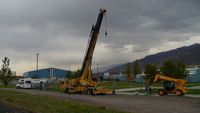 In the previous Climber / Power-Beaming competition portion of the Space Elevator Games, the ‘raceway’ tether was held aloft by a crane. Each year this tether distance became higher, culminating in a 400 foot tether in the most recent competition.
In the previous Climber / Power-Beaming competition portion of the Space Elevator Games, the ‘raceway’ tether was held aloft by a crane. Each year this tether distance became higher, culminating in a 400 foot tether in the most recent competition.
For this year’s competition, the raceway is a full kilometer long – and a crane just isn’t going to cut it. Several ideas were looked at including using a balloon, holding it up inside a (very tall) building, holding it up along side a (very tall) building, but in the end, the idea of using a helicopter to hold the raceway aloft turned out to be the best option.
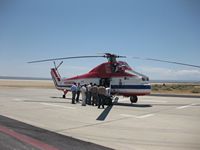 Though this solved the problem of how do you hold up such a long tether, it presented another problem – namely how does the helicopter pilot keep the aircraft in a relatively stable position? At such a height and in such a featureless location, this caused some concern.
Though this solved the problem of how do you hold up such a long tether, it presented another problem – namely how does the helicopter pilot keep the aircraft in a relatively stable position? At such a height and in such a featureless location, this caused some concern.
At the official website of the Space Elevator Games, Ben Shelef tells us how this problem was addressed. The solution is very ingenious…
(The first picture thumbnail is of the crane used in the 2007 competition. The second picture thumbnail is of the helicopter which is going to be used in this year’s Games. Click on either thumbnail for a larger version fo the picture)
Team LaserMotive
 At the 2007 Space Elevator Games, team LaserMotive made it’s first appearance. Many of us who closely followed the runup to the competition had high hopes for this team’s performance. They seemed to have all their bases covered, their climber was laser-powered (one of only two teams to be so), and enjoyed the assistance of a true laser expert, Dr. Jordin Kare.
At the 2007 Space Elevator Games, team LaserMotive made it’s first appearance. Many of us who closely followed the runup to the competition had high hopes for this team’s performance. They seemed to have all their bases covered, their climber was laser-powered (one of only two teams to be so), and enjoyed the assistance of a true laser expert, Dr. Jordin Kare.
Unfortunately, however, they were badly bitten by not being totally prepared in time for the competition. It’s easy to point fingers afterwards and say that they could have done a better job, but they, like everyone else, are doing this in their spare time. They have other things, like day jobs and family, that they have to balance with their Space Elevator passions. In retrospect, it was amazing that they had all of this equipment working at the Games – they were basically setting up a lab at the launch point every time it was their turn to make an attempt.
This time around, however, promises to be different. With a year’s experience under their belt, they are definitely loaded for bear. On the official website of the Space Elevator Games, Ben Shelef has put up a series of posts about LaserMotive’s qualification. To sum up, it appears that this team is READY…
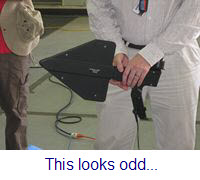 In Ben’s first post about team LaserMotive, he talks about how this team is using a laser supplied by DILAS. They are in the minority here, with only the McGill team joining them in using this system. The other four competitors are all using laser power supplied by TRUMPF. Because of this, there was only some reflectivity testing done onsite during the recent tests at Dryden – the main testing needed to be done at the LaserMotive facility.
In Ben’s first post about team LaserMotive, he talks about how this team is using a laser supplied by DILAS. They are in the minority here, with only the McGill team joining them in using this system. The other four competitors are all using laser power supplied by TRUMPF. Because of this, there was only some reflectivity testing done onsite during the recent tests at Dryden – the main testing needed to be done at the LaserMotive facility.
In the second post about LaserMotive’s qualification testing (which was done onsite at the LaserMotive facility), Ben writes in more detail about LaserMotive’s power source. Money quote: “The system uses two parallel beams, which originate in the two cube like devices at the back, are folded over several times as they bounce between the mirrors, and eventually exits through the top hatch after having bounced from the large bottom mirror. For testing, a last mirror is introduced at the top, diverting the beam so it comes out horizontally out the back of the trailer.”
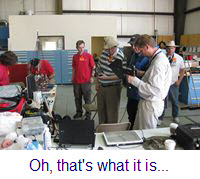 In the third post, Ben writes about how LaserMotive has their laser doing double-duty; powering a climber and cooking hot dogs. What, no beer?
In the third post, Ben writes about how LaserMotive has their laser doing double-duty; powering a climber and cooking hot dogs. What, no beer?
And in the fourth and final post (so far) about this team, Ben writes about the Climber “Melt Test”. In previous Games, the main issue was “Shake, rattle and roll” – worrying about how the climber would handle the wind and the subsequent twisting and oscillating of the tether. That is not so much a worry this year as the climbers are not climbing a tether, but rather a steel ‘rope’ (cable). There’s not much cross section for the wind to grab hold of. The teams (and Ben) ARE worried about if the climber can take the laser at full power for the length of the climb (plus some margin). Ben doesn’t give us the actual numbers, but you’ll note that he had no complaints.
 Check out these posts that Ben has put up – they’re most informative and fun to read. He has several pictures included, some taken by him and a couple taken by yours truly. You might also want to read a couple of previous posts (here and here) that I had put up about DILAS.
Check out these posts that Ben has put up – they’re most informative and fun to read. He has several pictures included, some taken by him and a couple taken by yours truly. You might also want to read a couple of previous posts (here and here) that I had put up about DILAS.
I think it’s time for me to start a pool for this competition – I’ll be on the phone to Las Vegas shortly…
(You can view larger versions of the pictures by clicking on the picture thumbnails. These pictures show NASA personnel doing their own testing of the LaserMotive climber)
KC Space Pirates status report
 I received this email today from Brian Turner, captain of the Kansas City Space Pirates:
I received this email today from Brian Turner, captain of the Kansas City Space Pirates:
In case you have not heard the games are now set for the 1st week in August. I have been reading about all of this and had it in my mind that everyone else knew. Sorry, let me give you a recap of all of the high intensity happenings.
The safety review triggered by the cable breaking is done and things are moving forward. There will be another helicopter test in about 2 weeks to make sure that there will not be any problems with that operation. There will also be another round of laser testing to accommodate the rest of the TRUMPF teams that did not get done during the last testing.
Lasermotive has also passed the qualification requirements so the number of qualified teams stands at 2. We are expecting 1 or maybe 2 more during the next round of testing.
The coverage of the KC Space Pirates on the Science channel was pretty good. With a good overview and coverage of the space elevator challenges. We went from being able to deliver good sound bites while projecting an air of professionalism to producing cheesy quotes while looking like a group of hobbyist working from our garage. I can’t complain, because we are a group of hobbyist working out of a garage and I suppose I am a little on the cheesy side. Oh well. They showed some of our sponsor logos and that is the most I could hope for. They also left out some of the most embarrassing footage. And it was all a lot of fun.
Our to-do list for the competition actually has an end in sight. That is good because the added test dates ate up most of the added time.
Brian Turner
It won’t be long now…
Sex in space
Our intrepid Space Elevator explorers deal with a ‘touchy’ subject…
[youtube]http://www.youtube.com/watch?v=h4iNgOR8tMQ[/youtube]
.
View all of the episodes here.
Space Elevator Day
 On Friday, July 17th, the Space Frontier Foundation will kick off their NewSpace2009 Conference at the NASA Ames Research Center in Mountain View, California with SPACE ELEVATOR DAY. This opening session will feature speakers from the Space Elevator effort including Bryan Laubscher, Martin Lades, Steve Steiner, Michael Laine and, assuming the Space Elevator Games testing (round 2) goes well, Ben Shelef.
On Friday, July 17th, the Space Frontier Foundation will kick off their NewSpace2009 Conference at the NASA Ames Research Center in Mountain View, California with SPACE ELEVATOR DAY. This opening session will feature speakers from the Space Elevator effort including Bryan Laubscher, Martin Lades, Steve Steiner, Michael Laine and, assuming the Space Elevator Games testing (round 2) goes well, Ben Shelef.
This event promises to be fun, exciting and informative. If you want to know what’s going on in the Space Elevator arena, first-hand, from the people who are making it happen, you should plan on attending this event.
Be there or be square!
Space Elevator Games have been rescheduled
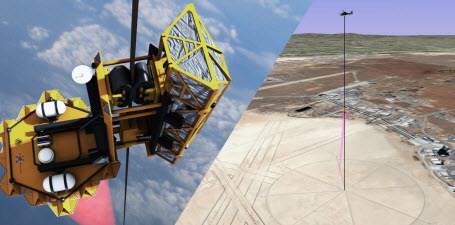 Over at the official site of the Space Elevator Games, Ben Shelef, CEO of the Spaceward Foundation (host of the Games, along with NASA), gives us the new dates for the second round of testing and the games:
Over at the official site of the Space Elevator Games, Ben Shelef, CEO of the Spaceward Foundation (host of the Games, along with NASA), gives us the new dates for the second round of testing and the games:
Jul 16-23 – Testing, Round 2
Aug 3-7 – The Games
Check out Ben’s post for the logic behind all of this.
Testing Results
 Over at the official website of the Space Elevator Games, blogger (and head of the Spaceward Foundation, host of the Games, and author of The Space Elevator Feasibility Condition) Ben Shelef has been detailing the testing results from last week.
Over at the official website of the Space Elevator Games, blogger (and head of the Spaceward Foundation, host of the Games, and author of The Space Elevator Feasibility Condition) Ben Shelef has been detailing the testing results from last week.
He has the results of the LaserMotive tests here and the results of the Kansas City Space Pirates tests here and here.
If you haven’t been following Ben’s website, you really should be. It is THE definitive source for information about the Space Elevator Games. Put it into your RSS reader – you won’t regret it…
KC Space Pirates to appear on the Science Channel
 I received this email from Brian Turner, captain of the Kansas City Space Pirates:
I received this email from Brian Turner, captain of the Kansas City Space Pirates:
Tomorrow night we are supposed the be on the Science Channel. Exodus Earth series Exoplanet episode. According to the guide on my TV it airs at 4 pm CST. They seem to be rerunning the episodes many times, so it is confusing if you are watching the first run or a previous episode.
http://science.discovery.com/tv-schedules/series.html?paid=48.15013.125384.36201.4
I have not seen this so I have no idea what to expect.
Brian Turner
The blurb for the show reads as follows:
In his hardest mission, Basil Singer plans a journey to Gliese 581c – a planet round a distant sun. To power him there within a human lifetime, he investigates space sails and nuclear bombs. He finds that the ‘second earth’ might have purple trees.
No mention of a Space Elevator, but as they’re talking about alternatives to rockets, it is plausible that at least a mention of a Space Elevator will be made – hopefully more.
The ‘Tomorrow night” Brian is speaking of is tonight, Friday, June 26th. According to the listings, however, this show is appearing a few times on the Science Channel, so you should have a chance to watch or TIVO it. As they say, check your local listings…
Ben Shelef appears on The Space Show
 On June 8th, Ben Shelef, CEO of the Spaceward Foundation, appeared on Dr. David Livingston’s The Space Show to discuss the upcoming Space Elevator Games, Power Beaming, Strong Tethers and Space Elevators in general.
On June 8th, Ben Shelef, CEO of the Spaceward Foundation, appeared on Dr. David Livingston’s The Space Show to discuss the upcoming Space Elevator Games, Power Beaming, Strong Tethers and Space Elevators in general.
 Ben’s Spaceward Foundation is the host of the Space Elevator Games, so he is THE MAN to discuss the topic of the Games. As well, with his recent publications (you can find them all here), most importantly, The Space Elevator Feasability Condition, I think it is safe to say that Ben is now pushing the research forward about the Space Elevator more than anyone else.
Ben’s Spaceward Foundation is the host of the Space Elevator Games, so he is THE MAN to discuss the topic of the Games. As well, with his recent publications (you can find them all here), most importantly, The Space Elevator Feasability Condition, I think it is safe to say that Ben is now pushing the research forward about the Space Elevator more than anyone else.
Check out the show here – it’s very interesting…
And be sure and check out the official site of the Space Elevator Games here…
Precious bodily fluids…
Our intrepid explorers are at it again…
[youtube]http://www.youtube.com/watch?v=2cB1PPtpv4k[/youtube]
.
Yeah…
View all of their episodes here.
Testing results summary from the KC Space Pirates
 I received this long and detailed email from Brian Turner, captain of the Kansas City Space Pirates. It does a better job than I could have of summarizing the testing results from last week. Both of the pictures in this post were also provided by Brian.
I received this long and detailed email from Brian Turner, captain of the Kansas City Space Pirates. It does a better job than I could have of summarizing the testing results from last week. Both of the pictures in this post were also provided by Brian.
The last week of testing was quite the ride. We are currently the only team to pass all of the pre-competition qualifying tests. We passed both safety and performance tests. It is eerily similar to the last competition where we were the clear leaders early and fell short at the last minute. We must be extra careful not to lose our focus.
We were the only team to show up on Monday. Most of the rest of the teams trickled in over the next few days. There was no required arrival time because the first day was just for planning and unpack. Tuesday was for helicopter testing. But due to a rain scare, that was pushed back to Wed. Apparently rain on a dry lake bed is a bad thing and can trap vehicles in mud that takes days to dry.
We spent a lot of time waiting. Because Edwards is an airforce base and Nasa Dryden Flight research center works on top secret stuff we had to have an escort everywhere we went once we entered the flight- line complex. This included if we wanted to get something to eat at the employee food court just a few blocks from the hanger that was Spaceward’s base of operations. Because everyone was heading in a hundred directions there was a shortage of escorts. We also had to get badges and passes, and watch safety videos. We did get to meet some really nice people as they were escorting us. Freddy and Elizabeth were great fun and very helpful. I can’t remember the other escort’s names as we were pretty busy when they were on escort duty out on the lakebed. The escorts all have regular duties. For example Elizabeth is a lawyer in the tech. transfer office.
We also learned about FOD (foreign object debris) This is basically rocks in the tire treads or kicked up into the gaps on the vehicles while they are out driving on the lakebed. This FOD can damage jet engines and create flying object safety hazards if allowed to track up onto the concrete flight-line area. Edwards is home to aircraft costing in the billions with a B. So they treat the flight-line as something like the houses where you take of your shoes off before walking on the carpet. So we have to get out and pick all of the rocks out out of the tires whenever we come in off of the lake bed.
All of this overhead took about a day of the total time we were out there. While I was waiting around I was analyzing (That’s what I do with every spare moment of my life.) all of this overhead and decided that none of it was unreasonable. If Spaceward had chosen a different place we could have avoided most but not all of this kind of overhead. However the safety requirements for an 8 Kilowatt laser turned loose are difficult to satisfy at any venue. And the added requirements for a helicopter with a 1.3 km long cable hanging from it are also a pretty tall bar.
Safety procedures and meetings took most of another day worth of time. I was expecting this overhead so was not that bothered by it. And perhaps a day or so waiting on Spaceward and the other teams. That left us with about 2 days that we spent working on our stuff. And that was time well spent, making up for all of the time spent waiting for everything else and the 4.5 days of total driving from Kansas City to Dryden and back.
We rented an RV in Vegas that was immensely helpful on the lakebed, in the campground and finally as the kitchen.
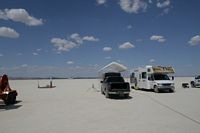 The Muroc dry lake bed is a thing to behold. Miles of flat dried mud with no people and almost no animals. It is the kind of place where you go to test dangerous stuff. It is also so stereotypically desert that many films and TV shows are done here. I believe that the Mythbusters episode where they were shooting bullets straight up is an example. I should also mention that it is dusty, windy and hot. There is clearly more dust than sand and it gets everywhere. Challenging all of our dust control measures and coating all of our optics with a fine layer that has to be cleaned every time before we fire the laser through our system.
The Muroc dry lake bed is a thing to behold. Miles of flat dried mud with no people and almost no animals. It is the kind of place where you go to test dangerous stuff. It is also so stereotypically desert that many films and TV shows are done here. I believe that the Mythbusters episode where they were shooting bullets straight up is an example. I should also mention that it is dusty, windy and hot. There is clearly more dust than sand and it gets everywhere. Challenging all of our dust control measures and coating all of our optics with a fine layer that has to be cleaned every time before we fire the laser through our system.
The heat is not bad in the morning or on cloudy days. But Thurs. and Fri. were brutal past midday. You almost lost a hand to having to hold a water bottle all the time.
As you may have heard by now, on Wednesday the cable broke while the helicopter was lifting it up into position. This was caused by the pulley on the bottom failing from the combination of high speed and high load. Either one of which would probably have been fine by itself. After the cable broke there was some confusion as to what the procedures were. That shut down operations for the day. We went to a debrief meeting that I had low expectations of. Quite the opposite happened. All of the background players were there and the Spaceward operation was reviewed for both procedural and systemic issues. A plan for making the plan was forewarded and all the concerned parties explained their point of view in a professional manner. I learned about issues that I did not know about and all of the concerns that I thought were being ignored were clearly spoken. It was something of a how-to lesson for me on complex operations.
During the time before the cable broke we actually learned a fair amount. The cable was well behaved. A dramatic change from the past 2 competitions where the flat ribbon we were climbing became an ill- behaved and fierce enemy to success. The winds were in my estimation higher than in the previous competitions. This also means that we may have overbuilt portions of our optics system. Better overbuilt than underbuilt.
We did not get to run our climber on the cable. That was to be the next step. So we will have to move forward without the benefit of the data that would have been gathered had we gotten to do this test.
Now on to the laser testing.
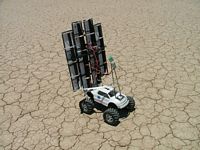 The surprise that we had planned for the testing was the RC truck. We have our climber solar panel mounted on it and it powers the thing. We had what is probably the world’s first laser powered truck. It worked well until we lost the telemetry signal and had to move on so that we could get in our stress test before the next team needed to take a turn with the laser.I am told that the video from this was awesome and I can’t wait to get my hands on it. I hope to have a version edited and posted to youtube for you guys to see soon.
The surprise that we had planned for the testing was the RC truck. We have our climber solar panel mounted on it and it powers the thing. We had what is probably the world’s first laser powered truck. It worked well until we lost the telemetry signal and had to move on so that we could get in our stress test before the next team needed to take a turn with the laser.I am told that the video from this was awesome and I can’t wait to get my hands on it. I hope to have a version edited and posted to youtube for you guys to see soon.
Many of the laser tests were just confirming that we did what the rule book said. All of the back and forth about this stuff over the last 2 or so years came down to a procedure that was as workable as I could ask for. The most feared test for me was the climber and optics stress test. We had to exceed the duration and power level that we wanted to use in the competition to make sure that we did not have any failures that could pose a safety problem. Of course our system was designed to be cutting edge and I can’t say that I have a good feel for where that edge falls off at. If we were going to fail a test this would be the one. The test went so well that I stopped it at the maximum desirable time as opposed to the point where the temps were hitting the safety limits. The big trouble that we had last time we were in front of the laser also seemed to be cured by the custom lens from our newest sponsor Asphericon.
As for our competitors:
Lasermotive is looking excellent. They are clearly operating even better than at the last competition and have reaffirmed their position in my estimate as being one of the top three. USST got delayed at customs and was only able to get 2 hours on the laser the last day of testing. From what I saw they are operating at a level consistent with previous years but I did not really see enough to be swayed one way or the other in thinking that they round out the top three with Lasermotive and us.
I did not see or hear anything from McGill or Alberta. It seems unlikely that they have full systems hiding somewhere so I have to be pessimistic that they will arrive in competitive form in 3 weeks.
NSS and M-climber came to laser testing with systems that failed to pass the required tests. There was however limited time for them to do so. I still think that they have more than 3 weeks work to do in the next three weeks.
Our testing this week grew a long list of items that need attention, so we will be very busy putting the finishing touches on our system over the next three weeks.
This is the longest newsletter I have ever written. But then this was clearly one of the most exciting weeks in KC Space Pirates history.
Brian Turner
Captain
KC Space Pirates
Thanks Brian. We have many more pictures and videos from the Testing that we will be posting here or at the official site of the 2009 Space Elevator Games. Stay tuned!
Testing and more testing…
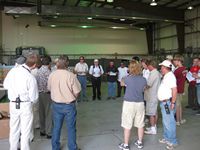 First a quick status update. Wednesday’s problem with the steel cable snapping was caused by a pulley failure. Once this pulley failed, it sheared the cable. This failure halted operations for the day so that all the relevant parties could get together and decide what happened and how to fix it. The pulley was rated for the load, but evidentally the very high spin rate of the pulley, with the load it was carrying, caused it to fail. A much more beefed up pulley should take
First a quick status update. Wednesday’s problem with the steel cable snapping was caused by a pulley failure. Once this pulley failed, it sheared the cable. This failure halted operations for the day so that all the relevant parties could get together and decide what happened and how to fix it. The pulley was rated for the load, but evidentally the very high spin rate of the pulley, with the load it was carrying, caused it to fail. A much more beefed up pulley should take 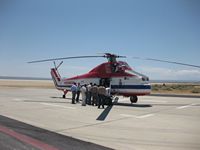 care of this issue. Other than that, Wednesday’s testing of the raceway setup went very well. Over at www.spaceelevatorgames.org, the official site of the Games, there are more details about this.
care of this issue. Other than that, Wednesday’s testing of the raceway setup went very well. Over at www.spaceelevatorgames.org, the official site of the Games, there are more details about this.
Today, Thursday, we began laser testing with the laser provided by TRUMPF. This also went very well. The Kansas City Space Pirates team were the guinea pigs in this testing. It took time to work out exactly what should be tested, how it should be tested, 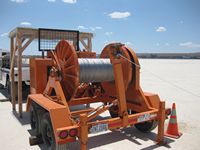 what the procedures should be for ‘laser protocol’, etc. The end result was that the laser system performed flawlessly and the Space Pirates system performed at a very high level too. The Space Pirates passed all of their tests save one, a stress test which will have their system handle the full-power (8 KW) laser feed from TRUMPF and do so for a length of time simulating how long they would need it to send their climber up the kilometer long cable. This will be done first-thing tomorrow morning. Once that is completed, the other teams here, ready to go, will also do their laser testing. Team LaserMotive also underwent laser testing and passed a less-stringent test (they did not have their full-power laser system onsite), so it was a good day all around…
what the procedures should be for ‘laser protocol’, etc. The end result was that the laser system performed flawlessly and the Space Pirates system performed at a very high level too. The Space Pirates passed all of their tests save one, a stress test which will have their system handle the full-power (8 KW) laser feed from TRUMPF and do so for a length of time simulating how long they would need it to send their climber up the kilometer long cable. This will be done first-thing tomorrow morning. Once that is completed, the other teams here, ready to go, will also do their laser testing. Team LaserMotive also underwent laser testing and passed a less-stringent test (they did not have their full-power laser system onsite), so it was a good day all around…
The first picture (above) is of an all-hands meeting held before testing began on Wednesday. Everyone who was involved in any way was required to attend this meeting. As you can see, it is quite a crowd.
The second picture (above) is of the helicopter we used. It is an S-58 and is supplied by Aris Helicopters.
The third picture (also above) is of the winch which holds the steel cable that the Climbers will be ascending/descending. This cable will be anchored on one end (the ground end) by the winch and on the other end (the up-in-the-air end) by the helicopter. The winch is the more active partner of the two; paying out and reeling in the cable as necessary.
 And, the last two pictures are of the local area. The first is of a Joshua tree (Yucca brevifolia). These trees grow in the desert here and are starkly beautiful. They can be seen all along the highway here in the Mojave desert.
And, the last two pictures are of the local area. The first is of a Joshua tree (Yucca brevifolia). These trees grow in the desert here and are starkly beautiful. They can be seen all along the highway here in the Mojave desert.
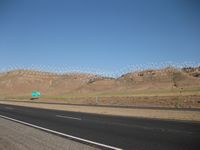 And finally, this last picture is a small portion of the enormous number of windmills in this area (the Tehachapi area). I am told that here in Tehachapi is where wind farms were started in the US. They’re amazing to see, both in their size and the sheer numbers of them around – there have to be several hundreds of them.
And finally, this last picture is a small portion of the enormous number of windmills in this area (the Tehachapi area). I am told that here in Tehachapi is where wind farms were started in the US. They’re amazing to see, both in their size and the sheer numbers of them around – there have to be several hundreds of them.
As always, click on any of the picture thumbnails for a larger version of the picture.
More tomorrow…
Status…
If you’ve been following our Tweets (www.twitter.com/SEGames) you’ll know that we had a problem today with the pulley and the cable. I was not at the lake-bed operations today (I was watching it on ustream along with many others) and I am not party to the after-mission meeting where this is all being discussed. So, take what I’m writing here with a grain of salt. I’ll try and differentiate between what I know and what I think I know.
I know that the cable broke. Everyone has confirmed this – I have seen pictures of it (and am waiting to get them from Danny Leafblad of the KCSpace Pirates so I can put them on this blog). I also know that the pulley that the cable was threaded through (the steel cable goes from the winch through the pulley and to the helicopter) broke. I have seen pictures of this, too.
What appears to have happened (and remember, this is subject to update based on the after-mission analysis going on now) is that the pulley broke first. It cause the cable to bend or catch on something. This weakened the cable so that it broke. No other links in the tether chain broke, and some were designed to break at forces well below the level necessary to break a ‘healthy’ cable. Because these links did not break, I’m forced to conclude that when the pulley broke, it caused the cable to break.
Now, why did the pulley break? Perhaps they know by now (and I certainly will update you when I do). It’s inconceivable to me that both Ben Shelef (the organizer of these Games and the engineer who designed this system) and the NASA review team would have overlooked the issue of the pulley rating. I’m guessing that somehow the cable was able to jump off of the pulley wheel and somehow lodge itself between the pulley wheel and its mounting bracket. Either that or the pulley itself was defective. Let me emphasize that this last paragraph is speculation on my part and when I know the answer, I’ll let you know.
I’ve also heard (second-hand) that there is no chance of the helicopter flying tomorrow because of some scheduling conflict, so further testing of this sort may need to be put off until just before the Games. Again, I’m not sure, but will let you know.
On the bright side, overall the system seemed to perform very well; the helicopter and winch we’re able to work together to reel-out and reel-in the cable satisfactorily. The winch operator, tether handler and helicopter personnel all were able to practice working together under real (not simulated) conditions. The NASA TV team was able to get some practice in filming helicopter and winch activities and, if you tuned into their Ustream live broadcast, you were able to see it. The target at the top of the tether functioned properly. I am unaware at this time of any other significant problems that happened during the operation.
Also on the bright side, the TRUMPF people say that there laser is all set up and operating at full-capacity with no issues. This means that both the Kansas City Space Pirates and LaserMotive should be able to laser-qualify their climbers (checking for reflections, etc.) tomorrow.
So, that’s the status. I’ll update you as soon as I have more/better information.
The helicopter is HERE…
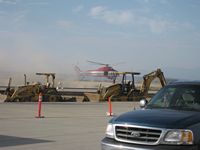 The helicopter arrived this morning, on time (early, even). It is an S-58 and will be exactly the same type which is used at the Games. I got this picture of it while it was landing, just before it was obscured by the dust it was kicking up…
The helicopter arrived this morning, on time (early, even). It is an S-58 and will be exactly the same type which is used at the Games. I got this picture of it while it was landing, just before it was obscured by the dust it was kicking up…
The helicopter test today is HUGE – we really need this to work right. Having said that, it looks like all the ducks are in a row. The winch testing from yesterday went well, the hardware is in place, teams are here, TRUMPF is here with its laser and NASA is doing a great job of coordinating everything.
As always, click on the thumbnail for a larger version of the picture.
I’d like to be blogging more, but the data connection here is not very good – I can do Tweets (follow us at SEGames), but blogging requires more bandwidth – tough for us outsiders to get here. But we’re working on improving that too – after all, this is ‘test week’…
As always, click on the picture thumbnail for a larger version…
Updates from the LaserMotive team
 On the LaserMotive Blog, a couple of new entries have been posted.
On the LaserMotive Blog, a couple of new entries have been posted.
The first one has to do with cooking hot dogs. Now, you might reasonably ask what this would have to do with a Space Elevator or the Space Elevator Games. Well, if you read the post, you’ll find that high-powered lasers can do other things besides powering Climbers…
The second post has to do with stress testing, both planned and unplanned. It is an axiom of good system’s engineering that you can never do enough testing. As a veteran of many years with software systems, I can attest to the truth of this. But sometimes a planned test can turn into an unplanned test. Check out this LaserMotive post (complete with video) showing how they have been stress-testing their climber.
Finally, as noted via Twitter (follow us at SEGames for the latest updates as they happen), the LaserMotive team has arrived here at the NASA Dryden facility (where the Games will be held this year) for onsite testing.
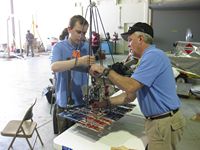 This first photo is of the climber that they’ll be using for the tests. I’m told that this is “Rev 1” of the climber which will be used. It’s much lighter and stronger than the one they used the last time around. I and everyone else here will be very interested to see how it performs. LaserMotive is now a ‘blooded’ team and I’m sure there are many, many ‘lessons learned’ from the previous competition built into this climber.
This first photo is of the climber that they’ll be using for the tests. I’m told that this is “Rev 1” of the climber which will be used. It’s much lighter and stronger than the one they used the last time around. I and everyone else here will be very interested to see how it performs. LaserMotive is now a ‘blooded’ team and I’m sure there are many, many ‘lessons learned’ from the previous competition built into this climber.
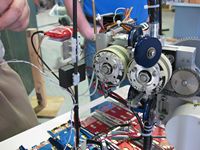 The second photo is a close-up of the wheels which actually grip the cable. These wheels come from an inline skate, ground down to the proper diameter. It’s tough to go to a company catalog (even from someone like McMasters) and look for “Space Elevator Climber drive wheels” – so LaserMotive (and all the other teams, of course) have to adapt parts from other devices or custom-make them.
The second photo is a close-up of the wheels which actually grip the cable. These wheels come from an inline skate, ground down to the proper diameter. It’s tough to go to a company catalog (even from someone like McMasters) and look for “Space Elevator Climber drive wheels” – so LaserMotive (and all the other teams, of course) have to adapt parts from other devices or custom-make them.
It’s part of the Challenge 🙂
(Click on either of the picture thumbnails for a larger version)
What’s wrong with this picture?
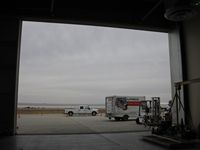 What’s wrong with this picture indeed…
What’s wrong with this picture indeed…
This picture was taken early this afternoon, looking out the hanger/warehouse/workshop where we’ve headquartered and are putting together all our stuff. Outside this building is the Edwards Air Force Base in the Mojave desert. This is June. It is supposed to be bright and sunny. Instead it’s overcast and there is a forecast of rain.
Unfortunately, it has cancelled any chance we had of doing a test flight tomorrow. This means that this testflight will happen, at the earliest, on Wednesday. This also means that an already tight schedule has gotten even tighter.
I’m VERY GLAD that the NASA people here are truly a ‘can do’ crowd. They want to make this happen and are pulling out all the stops to do so. So, being late will be a problem, not a potential disaster.
Rain in the Mojave in June?
(click on the picture thumbnail for a larger version)
More Monday Nuts & Bolts…
Here are some more pictures from today’s work…
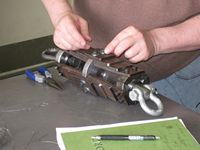 This first picture is of a reusable breakaway link, a safety device attaching the kilometer-long steel cable that the climbers will be ascending/descending to the helicopter. It has a rated release point of 3,500 pounds. This means that in the unlikely event where the helicopter is pulling on the cable with that much force (or more), then the link will separate and the helicopter will be free of the tether.
This first picture is of a reusable breakaway link, a safety device attaching the kilometer-long steel cable that the climbers will be ascending/descending to the helicopter. It has a rated release point of 3,500 pounds. This means that in the unlikely event where the helicopter is pulling on the cable with that much force (or more), then the link will separate and the helicopter will be free of the tether.
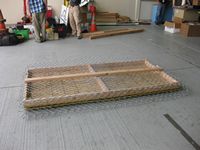 Of course, if that happens, the cable and anything that might be on it (like a Climber) is going to fall. All of the teams and the NASA and Spaceward personnel will be inside trailers, protected from falling debris. However, the person operating the winch (which pays out and retracts the steel cable) is out in the open. And that’s the subject of this next picture. An overhead shelter is being built for the winch operator. This picture is of the ceiling for that shelter. The combination of chain-link fence, 2×4′ and plywood should keep the operator safe.
Of course, if that happens, the cable and anything that might be on it (like a Climber) is going to fall. All of the teams and the NASA and Spaceward personnel will be inside trailers, protected from falling debris. However, the person operating the winch (which pays out and retracts the steel cable) is out in the open. And that’s the subject of this next picture. An overhead shelter is being built for the winch operator. This picture is of the ceiling for that shelter. The combination of chain-link fence, 2×4′ and plywood should keep the operator safe.
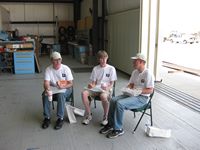 And this last picture is of the KC Space Pirates crew, enjoying a bit of lunch. They’re hard workers – I guess they’ve earned it 🙂
And this last picture is of the KC Space Pirates crew, enjoying a bit of lunch. They’re hard workers – I guess they’ve earned it 🙂
Tomorrow or Wednesday should see the arrival of at least 2 more of the teams. Also, the filming crew from the Chicago video production company Bitter Jester Creative, Inc. will be arriving tonight. This group has been filming the competition and the participants and the organizers for the past few years. While certainly interested in he technical coolness of these games, they are focusing on the human element. I think their final product is going to be fascinating…
(Click on any of the picture thumbnails for a larger version)
Monday first tasks…
 We’re now here at Dryden, on the base, in the workshop, beginning to put the physical structures in place for this year’s Space Elevator Games (the planning structures were started long ago). Today is a day for building stuff (‘swinging a hammer’) and, if all goes according to plan, we hope to do our first actual flight test at noon tomorrow. That’s extraordinarily ambitious, but we’re going to give it a go as they say.
We’re now here at Dryden, on the base, in the workshop, beginning to put the physical structures in place for this year’s Space Elevator Games (the planning structures were started long ago). Today is a day for building stuff (‘swinging a hammer’) and, if all goes according to plan, we hope to do our first actual flight test at noon tomorrow. That’s extraordinarily ambitious, but we’re going to give it a go as they say.
 Here are a couple of early pictures from today. The first shows the KC Space Pirates trailer (the Space Pirates are currently the only team on site – though others are supposed to show up this week too) while the second shows some Spaceward Volunteers and NASA shop personnel getting their hands dirty.
Here are a couple of early pictures from today. The first shows the KC Space Pirates trailer (the Space Pirates are currently the only team on site – though others are supposed to show up this week too) while the second shows some Spaceward Volunteers and NASA shop personnel getting their hands dirty.
More here later and also on the official website of the Games, www.spaceelevatorgames.org.
If you want to follow things minute-by-minute, I’m also using Twitter – follow me as “SEGames”…
(Click on the picture thumbnails for a larger version)
Things get testy on the Space Elevator…
Our intrepid explorers are getting bored and a mean streak is beginning to surface. It all ends with the dreaded Romulan Throat Thrust. Oh the humanity…
[youtube]http://www.youtube.com/watch?v=13aiNkf4Vq0[/youtube]
.
Watch all of the adventures of heroes here.
And, there is now a rumor that they may be planning something for the Space Elevator Games – stay tuned!
And so it begins…
My other project is finished and I’m now transitioning to “Space Elevator Week”. I’ll get a few hours of sleep tonight before I’m off to LAX tomorrow. Then I’ll pick up a car and head on out to Mojave to meet up with Ben Shelef, CEO of the Spaceward Foundation (hosts of the Space Elevator Games) and various Climber / Power-Beaming team members.
This coming week is critical and unprecedented; because of the sophistication of the Games this year, Ben has been able to set up a ‘test week’ to iron out the inevitable kinks; both in the Games themselves and in the reporting/publicizing of them.
We’ll have a helicopter, we’ll have a winch, we’ll have a steel cable, we’ll have climbers, we’ll have lasers and we’ll have bodies – This coming week is intended to put it all together so that when the actual Games happen (the week of July 13th), all of the teams will have the maximum opportunity to put together a winning climb.
This is the year to make it happen. We’ve been so close before, now it’s time to get it done…
I’ll be blogging a lot during the coming week, but I hope to be Twittering even more. They have excellent Verizon coverage at the base and, as I’m a Verizon user, I should be able to Twitter away on my Palm Treo. So, if you want to stay up to date with all of the events as they happen, follow me on Twitter (see my Twitter updates on the sidebar of this blog – follow me as “SEGames”, not as ‘tedsemon’).
And while there will be updates here, too, on my blog, the official site of the Games is www.spaceelevatorgames.org.
This should be exciting!
On hiatus…
No, nothing is wrong, I’m taking a short break from blogging. I’m spending this week traveling through central and southern Illinois surveying climate stations. This is part of a nation-wide project to see how reliable this network really is. If you want to learn more about it and what I’m doing with it, visit http://www.surfacestations.org.
It’s been much fun and very refreshing. Just me, the open road, Google Earth and Verizon wireless – what more does one need? And truly, being able to get away from everything else for a week and visiting people in small towns is good for the soul. I may make this a yearly pilgrimmage.
A small aside about Verizon data service; it’s freaking awesome. I have been to the smallest of the small towns (Boody, Assumption, Oconee, Nokomis, etc.) in our state and the data service seems to work everywhere. It is beyond cool to use Google Earth, live, on my laptop, while I’m traveling…
Anyway, check out what Ben has been blogging at the Official WebSite of the Space Elevator Games; http://www.spaceelevatorgames.org. You can stay up to date with the preparation for the Games there.
Testing for the Space Elevator Games begins next week. I fly out to LAX on Sunday and will spend the entire week at Dryden. I’ll have lots to post then…
A message from USST
On the USST website, a “Message from the President” was recently posted. An excerpt:
“We have the basics of the logistics figured out but once we get a final date and a bit more information we can finalize the plans. It will be nice for the team to work towards a date instead of just working all the time without a real end in sight.”
As the date of the competition IS now established, I’m sure the USST team is now very busy ‘finalizing their plans’. This team has to be considered as one of the favorites, considering their ‘best-in-show’ performances in all of the previous Climber / Power-Beaming competitions. The video below is their best performance from the 2007 Games held near Salt Lake City in Utah. They needed to be to the top in< 50 seconds but arrived in ~54 seconds – very close indeed.
[youtube]http://www.youtube.com/watch?v=jFx_mWCpa9o[/youtube]
.
As we’ll be almost certainly running the competition during the day, we won’t have any of these cool night shots this time around…
The Spaceward Press Release
And here is the text of the official Spaceward Press Release about the upcoming Space Elevator Games:
2009 Space Elevator Games to take place on July 14 at the NASA Dryden Flight Research Center in California’s Mojave Desert
June 1, 2009 (Mountain View, CA) NASA’s Centennial Challenges Program, NASA’s Dryden Flight Research Center, and the Spaceward Foundation are announcing that the 2009 Power-Beaming Challenge, part of Spaceward’s Space Elevator Games, will be held at NASA’s Dryden Flight Research Center at the Edwards Air Force Base in California’s Mojave Desert on July 14, 2009.
“We are very pleased that we can host this year’s Climber / Power-Beaming competition at our facility” said John Kelly, Deputy Mission Director for Exploration at the Dryden Flight Research Center. “Dryden has a rich history of research into the technologies of tomorrow, reaching back to the first supersonic flights and then later to the Apollo lunar missions. The Space Elevator can revolutionize our ability to travel to space, and it is only natural that testing of the concept will take place at our facilities.”
The Space Elevator is a revolutionary space transportation system based on a tether that extends from the surface of the Earth upwards to a counterweight located well beyond geosynchronous orbit and kept taut due to the rotation of the Earth. Electric vehicles, called climbers, ascend the ribbon using solar power and power transferred from the ground using a laser beam.
“Centennial Challenges explores high-risk, high-payoff ideas using technology prize competitions to encourage and reward innovation”, said Andrew Petro, manager of NASA’s Centennial Challenges program. “We’re happy to see that the Power Beaming challenge has matured to its current level, and anticipate technology innovations in power beaming that may be useful for NASA’s exploration missions and in other applications”.
This is the fourth year for the Space Elevator Games and each year the competition has grown more sophisticated. The first competition required teams to ascend a 50 meter tether at an average speed of 1 meters/second. The climbers were powered by spotlights provided by Spaceward. This year, to be eligible for the $2,000,000 prize, the competitors will be required to race their laser-powered vehicles up the 1 kilometer vertical steel cable at an average speed of 5 meters/second.
“We are thrilled to be working with the people at NASA HQ and Dryden” said Ben Shelef, Founder of the Spaceward Foundation, host of the Space Elevator games. “NASA is a symbol of mankind’s quest to explore space and Dryden is the symbol of beyond-cutting-edge technology development. The people and atmosphere here are everything the ‘Right Stuff’ was all about. This year’s challenges will feature several teams from the US and Canada competing for $2,000,000 of prize money, and it promises to be a spectacular race. Most of the teams competing this year are veterans of past competitions and they are now the experts in this field.”
The Space Elevator will make access to space easy, safe, scalable and affordable. The quality of the ride is comparable to a train ride, and since the Space Elevator does not carry fuel, it is inherently safe. Space Elevators can be made to lift 10, 100 or even 1,000 tons at a time.
The Space Elevator was first proposed by Yuri Artsutanov, a Russian engineer. The scientific principles underlying it are well understood and the fundamental materials and technologies required for its construction are within reach. The Space Elevator games concentrate on two of the most important ones —Nano-materials such as Carbon Nanotubes for strong structures, and power beaming for wireless power transfer.
The Spaceward Foundation is a public-funds non-profit organization dedicated to furthering space science and technology in education and in the public mindshare. Spaceward Foundation intends to bring together leaders from the academic, commercial and educational worlds and create a series of challenges, exhibits, and educational activities that will re-invigorate the nation’s interest in space.
NASA’s Centennial Challenges promotes technical innovation through a novel program of prize competitions. It is designed to tap the nation’s ingenuity to make revolutionary advances in technology of value to NASA and the nation. NASA’s Innovative Partnerships Program Office manages the prize program.
===================================
News media wishing to obtain credentials to cover the Power Beaming Challenge must submit a request for accreditation to the NASA Dryden Flight Research Center public affairs office by the following deadlines:
• Foreign nationals and U.S. citizens representing foreign-based media June 05
• U.S. citizens and aliens with permanent residency status representing domestic media July 07Media representatives seeking credentials must work for a legitimate, verifiable newsgathering organization. Accreditation requests may be e-mailed to DrydenPAO@nasa.gov for media representatives who have been accredited by NASA Dryden within the past year.
Otherwise, requests on company letterhead may be e-mailed to the above address or faxed to (661) 276-3566. Requests must include a phone number and business e-mail address for follow-up contact. No substitutions of non-credentialed media representatives will be permitted.
U.S. citizens must furnish: full name, date of birth, place of birth, media organization, the last six digits of social security number and driver’s license number, including issuing state.
In addition, foreign nationals must furnish: current citizenship, visa or passport number, country of issue and expiration date. Foreign nationals representing domestic or foreign media with permanent residency status must provide their alien registration number and expiration date.
===================================
Spaceward contact: Ted Semon (630) 240-4797
NASA Centennial Challenges contact: Andy Petro (202) 358-0310
Dryden Flight Research Center contact: Alan Brown (661) 276-2665
For more information about the Spaceward Foundation, please visit: www.spaceward.org
For more information about the Space Elevator Games, please visit: www.spaceelevatorgames.org
For more information about the Centennial Challenges, please visit: www.centennialchallenges.nasa.gov
———————————-
A pdf version of this press release is available here.
It’s on!!
 Finally! The Space Elevator Games are ON! The Climber / Power-Beaming competition will be held at the NASA Dryden Flight Research Center located at the Edwards Air Force Base in southern California.
Finally! The Space Elevator Games are ON! The Climber / Power-Beaming competition will be held at the NASA Dryden Flight Research Center located at the Edwards Air Force Base in southern California.
The date of this competition will be July 14, 15 and 16 (of this year!)
Because of the logistics involved, mainly the use of high-powered lasers and the competition’s location at a secure facility, it will not be open to the public. At http://www.spaceelevatorgames.org, which is the official site of this competition (or on this blog, of course) you will be able to follow all of the events as they are happening. The competition will be televised, live, on NASA TV. There will be webcasts and interviews. There’s going to be all sorts of cool stuff going on.
Yes, it’s been a long time coming, but the wait will be worth it. It appears that we have six serious competitors – all with laser-powered climbers and all ready to rock.
An ‘official press release’ will be sent out early next week. Stay tuned to this blog or the official Space Elevator Games website for more details.
The benefits of sharing…
Our intrepid elevator riders are back with another two episodes. Someone has, evidently, pressed all the buttons, so it appears that this trip is going to take some time.
In episode 4, we learn that “Rappaport” is a jokester and in episode 5 we learn the alleged benefits of sharing…
[youtube]http://www.youtube.com/watch?v=e3z7NUubWZo[/youtube]
.
[youtube]http://www.youtube.com/watch?v=8bmJq4kmAlM[/youtube]
.
All of their videos can be found here…
Patience…
 Really, really and truly, really and truly and most honestly…
Really, really and truly, really and truly and most honestly…
An announcement (positive, joyous, happy, good, etc.) is coming up real-soon-now about the upcoming Space Elevator Games. Some of the holdup has been from this agency which, well, has had a couple of other things (here and here) to deal with…
Please don’t press all the buttons…
Reader Sean Keane sent me a link to 3 new Space Elevator videos that he and his friends have produced. The theme is pretty self-explanatory and the videos definitely made me laugh.
It looks like these videos are the first in a series and I’m looking forward to future releases. My personal favorite of these is Episode Two…
[youtube]http://www.youtube.com/watch?v=FegIxglctUc[/youtube]
.
[youtube]http://www.youtube.com/watch?v=h7ZabdMIYcc[/youtube]
.
[youtube]http://www.youtube.com/watch?v=UWV26IG_9Dc[/youtube]
.
The home website for these videos is http://elevator2space.com/ and at this site we will, presumably, see future episodes. I’ll be posting them here, too, when they appear.
Thanks Sean – I look forward to future efforts from you and your cohorts – I think there is a definite chance that the four of you can become cult heroes…?
The LaserMotive team welcomes a new sponsor
 On the LaserMotive blog today, there was a post about a new team sponsor, 4D Optical. From the blog post:
On the LaserMotive blog today, there was a post about a new team sponsor, 4D Optical. From the blog post:
The guys from 4D Optical have a deep background in optical engineering, including some great expertise in
long-distance beam alignment. They’ve been doing a great job helping us out with our optical alignment procedures as well as providing some extremely useful hardware, all of which has enabled us to redirect (as it were) our energy towards other high-priority tasks.
Read the blog post for all of the details.
And really, really and truly, really and truly and absolutely, there is an announcement coming up very soon now about this year’s Space Elevator Games. Really there is, really…
The latest from the KC Space Pirates
 I received this email today from Brian Turner, captain of the Kansas City Space Pirates:
I received this email today from Brian Turner, captain of the Kansas City Space Pirates:
And the winner is “The Black Diamond”. That will be the name given to our new ship/trailer. The most suggested name was “Black Pearl” followed by “Queen Ann’s revenge”. We also had other fun suggestions like “The Really Really Mean Minnow” and “Red Eye Roger”. It was all fun and we also collected good names for the climber. Additionally we named the laser beam director the “ARGH” for Automated Robotic Glow Hurler. Oddly, they want a name for the laser on safety forms and such and just calling it the TRUMPF Trudisk 8000 does not differentiate it from the other teams. I am curious to see it the officials can bring themselves to calling it that. Or if they just keep calling it the Space Pirates beam director.
The upside in the competition date getting delayed repeatedly is that all the testing that we said we would do we are actually getting around to. And that is a good thing as we keep finding and fixing numerous problems. In the winter we often got pinned inside by the cold and could not test. Now, it’s the rain. But I would rather be wet then cold and there is something naturally optimistic about the springtime. But we still have gotten in enough testing to make me comfortable that we will be ready in time for the competition. At this point all of the long lead time items that we worried about getting done in time are no longer a problem. And we have gone through a few cycles of test, fail, fix. There are still items that could use improvement, but then, I think that is always the case.
I have tired of taking pictures and video that we can’t share with anyone yet. And I know that after the competition most of those pictures and video will be somewhat out of date. I will release some of it once we have a firm date for the competition.
The t-shirts are designed and available. I owe a few to some of you on this list, so now is good time to remind me. You can buy them directly from http://www.printfection.com/kcspacepirates
We have raised more funds to the point where even with the delays, we are not in danger of running completely dry before the competition. The testing itself is eating up money and looks like it will be even worse before the competition. Looks like we can get time on the helicopter for something north of $3000 or $1 per second. With costs like that, you know you are playing with the big boys.
With spring coming to a close, we will also have to work in the heat of summer. Glad we got that A/C on the new trailer.
See you laser… I mean later.
Brian Turner
Captain
KC Space Pirates
Thanks for the update Brian. I voted for the “The Really, Really Mean Minnow” and I’m glad to know that it was at least considered… ?
And, really and truly, there will be an announcement about the date of the Space Elevator Games coming out ‘Real Soon Now’. No, really, truly, really, I mean it, really…
This could work for a Space Elevator too…
 An interesting article appeared today on SpaceRef.com entitled “More ‘Star Trek’ than ‘Snuggie’: Student Design to Protect Lunar Outpost from Dangerous Radiation“. It seems that “…a group of students at North Carolina State University has developed a “blanket” of sorts that covers lunar outposts – the astronauts ‘ living quarters – to provide astronauts protection against radiation while also generating and storing power.”
An interesting article appeared today on SpaceRef.com entitled “More ‘Star Trek’ than ‘Snuggie’: Student Design to Protect Lunar Outpost from Dangerous Radiation“. It seems that “…a group of students at North Carolina State University has developed a “blanket” of sorts that covers lunar outposts – the astronauts ‘ living quarters – to provide astronauts protection against radiation while also generating and storing power.”
Something like this ‘blanket’, if truly feasible, could work for a Space Elevator too:
“The “lunar texshield” is made from a lightweight polymer material that has a layer of radiation shielding that deflects or absorbs the radiation so astronauts are only exposed to a safe amount. The outermost surface of the shield includes a layer of solar cells to generate electricity, backed up by layers of radiation-absorbing materials. The advantages of the materials used in the design include flexibility, large surface area, ease of transportation, ease of construction and the ability to have multiple layers of independent functional fabrics.”
The students present their findings at the 2009 RASC-AL forum in Cocoa Beach.
(Picture of Linus from here)
“What’s a Factor of 1,000 Among Friends…”
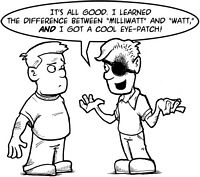 On the LaserMotive blog, we are humorously reminded about the potential dangers of lasers…
On the LaserMotive blog, we are humorously reminded about the potential dangers of lasers…
Visit their blog to view a full-size version of the cartoon, plus read about how it came to be…
Schlock Mercenary rocks!
Dr. Bryan Laubscher appears on The Space Show
 I missed this one…
I missed this one…
Last Monday, Dr. Bryan Laubscher appeared on David Livingston’s The Space Show. Bryan and David discussed the state of Space Elevator ‘affairs’ and the upcoming Space Elevator Conference (Aug 13-16).
Dr. Laubscher’s bio:
Bryan E. Laubscher received his Ph.D. in physics in 1994 from the University of New Mexico with a concentration in astrophysics. In 2008 Bryan left Los Alamos National Laboratory to pursue new adventures in the Redmond, WA where he and his wife now live. In 2006 Bryan spent a year on Entrepreneurial Leave to Seattle. There he started a company to develop the strongest materials ever created. These materials are based upon carbon nanotubes – the strongest structures known in nature and the first material identified with sufficient strength-to-weight properties to build a space elevator. At LANL he is was a project leader and has worked in various capacities for 17 years. His past projects include LANL’s portion of the Sloan Digital Sky Survey , Magdalena Ridge Observatory and a project developing concepts and technologies for space situational awareness. Over the years Bryan has participated in research in astronomy, lidar, non-linear optics, space mission design, space-borne instrumentation design and construction, spacecraft design, novel electromagnetic detection concepts and technologies, detector/receiver system development, spectrometer development, interferometry and participated in many field experiments. Bryan led space elevator development at LANL until going on entrepreneurial leave in late 2005.
And, thanks to the miracle of podcasting, none of us missed the show (though we did miss a chance to call in and ask Dr. Laubscher questions). Click here to listen to the show or visit The Space Show’s website.
Why you should join ISEC – Part 4
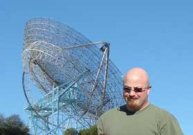 In the 4th installment of this series, Ed Gray, the head of ISEC’s Business Pillar, tells why he thinks everyone who wants to see a Space Elevator built should join ISEC:
In the 4th installment of this series, Ed Gray, the head of ISEC’s Business Pillar, tells why he thinks everyone who wants to see a Space Elevator built should join ISEC:
ISEC is the team that will be known in the future for catalyzing the scientific, outreach, legal and business work that give the Space Elevator to the world. If it seems like Sci-Fi or magic, just think of the iPhone, social networking, remote surgery and other mainstays of our lives – a few decades ago. All would have been considered magic, but they emerged through, creative thinking, experimentation, debate, audacity and through the teamwork of experts from many disciplines and from many parts of the world.
My first Space Elevator Conference in Seattle was life-changing. If you go, you might see a theoretical mathematician from Armenia, a finance entrepreneur from Texas, a carbon nanotube scientist from Seattle or a playwright from San Diego. You may also be like me – a new contributor to the work being done to design, plan and implement the Space Elevator. The people and proceedings of the conference make it tough to resist getting involved. The experts and enthusiasts of ISEC will be the steam that keeps this train moving – straight up…
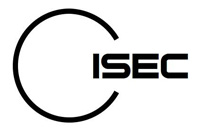 Thank you Ed. The Business Pillar of ISEC, as noted on the ISEC website, is charged with:
Thank you Ed. The Business Pillar of ISEC, as noted on the ISEC website, is charged with:
Space today is dominated by government business. But shipping and air travel isn’t. The Space Elevator may be built for security reasons or “national pride”, but its capacity can only be satisfied by a real space-based economy. The business pillar examines the economics of the Space Elevator.
Another focus of the business pillar are the stepping stones that lead from here to there – the ability to advance component Space Elevator technologies by building self-contained business cases around them even before the Space Elevator exists. Carbon Nanotubes are the obvious example, but not the only one.
As a specific objective, it is also important to analyze the connection and synergy between the Space Elevator and Space Based Solar Power. It may very well turn out that you can’t have one without the other.
To really exploit Space, we need a Space Elevator. Ben Shelef, CEO of the Spaceward Foundation (host of the Space Elevator Games) often jokes that we should be talking to the Department of Transportation rather than NASA about building a Space Elevator.
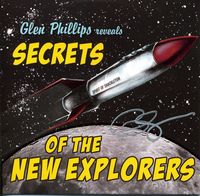 One other ISEC-related note; One of the benefits of joining as a “Standard” member is receiving an autographed copy of Glen Phillips CD, Secrets of the New Explorers. This CD has, IMHO, the best Space Elevator song written so far – and the rest of the album is pretty cool too. I reviewed this CD back in February of last year. We received the first batch of autographed CDs from Glen today and they will be going out in the mail soon to those who have signed up. For the rest of you who haven’t, I urge you to join ISEC today. Momentum is building and you can be a part of it and help make a Space Elevator happen – JOIN!
One other ISEC-related note; One of the benefits of joining as a “Standard” member is receiving an autographed copy of Glen Phillips CD, Secrets of the New Explorers. This CD has, IMHO, the best Space Elevator song written so far – and the rest of the album is pretty cool too. I reviewed this CD back in February of last year. We received the first batch of autographed CDs from Glen today and they will be going out in the mail soon to those who have signed up. For the rest of you who haven’t, I urge you to join ISEC today. Momentum is building and you can be a part of it and help make a Space Elevator happen – JOIN!
Using a Space Elevator to generate 1g…
Someone commented with an interesting question on a YouTube video I posted last year:
“I wonder how far from the earth the end of the cable would have to be to allow for the equivalent of 1G due to centrifugal force.”
I didn’t know so I asked Ben Shelef, CEO of the Spaceward Foundation (host of the Space Elevator Games) – this was his reply:
At any point on the tether, in your reference frame, you have two forces (accelerations) acting on you. Gravity downwards, and the centrifugal acceleration outwards.
Gravity diminishes with distance square, so at a height of 6000 km, you’re at double the distance from the center of the earth as you were when you took off, and so the force of gravity is 1/4 what it was.
At ground level, the centrifugal acceleration is very small, but it increases linearly with the radius. (a=omega^2*r) [omega is the spin rate of the Earth].
At GEO, the two accelerations are equal. (and each is very small, basically 1/50g)
So as we move out, at some point, the outwards acceleration will equal 1g. how far? We can neglect gravity, since it diminishes even further. The Centrifugal acceleration has to increase a factor of 50! So 50 times as far as GEO – way beyond the end of a 100,000 km long tether.
Using numbers;
- omega is 6.28/24/3600 = 7.3E-5 1/Sec
- omega-square is 5.3E-9 1/Sec2
- r = g/omega2 = 1.9E9 m, or 1.9E6 km – or ~20 times longer than the 100,000 km tether
The mean distance between the earth and the moon is ~384,400 km, so a tether long enough to generate 1g at its tip would need to be nearly 5 times LONGER than that mean distance between the earth and the moon! I don’t think we’ll be seeing it anytime soon ?
Designs for a Space Elevator Base Station
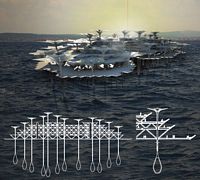 In the Department of Architecture at California State Polytechnic University, Professor Michael Fox had his students do a very cool and relevant project, a design of an ocean-based base station for a Space Elevator. As far as I know, this is the first time that people from the Architecture world have had a go at this. When the time comes to actually design a real base station, we will need the Architects to work along with the Engineers in order to design this right. Yes, we could just have a floating platform that looks like an ocean-based oil rig, but why not make it aesthetically pleasing as well? Plus, architects are going to include amenities and other practicalities that would not be obvious to engineering-type designers.
In the Department of Architecture at California State Polytechnic University, Professor Michael Fox had his students do a very cool and relevant project, a design of an ocean-based base station for a Space Elevator. As far as I know, this is the first time that people from the Architecture world have had a go at this. When the time comes to actually design a real base station, we will need the Architects to work along with the Engineers in order to design this right. Yes, we could just have a floating platform that looks like an ocean-based oil rig, but why not make it aesthetically pleasing as well? Plus, architects are going to include amenities and other practicalities that would not be obvious to engineering-type designers.
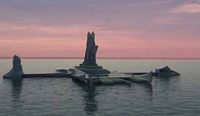 There are 11 designs in all – each of them really outstanding. I invite you to visit the main project website and look at the effort each of these teams have put into this project and the level of thought and detail that they have included. I hope to be writing more about this project in the near future.
There are 11 designs in all – each of them really outstanding. I invite you to visit the main project website and look at the effort each of these teams have put into this project and the level of thought and detail that they have included. I hope to be writing more about this project in the near future.
The two picture thumbnails in this post are cut from two of the projects. The topmost one is from the INTERFASE project, created by the team of Ehsaan Mesghali and Owen Liu. The bottom one is from another project (I’m unsure of the team that created this one, but I’ll find out ?). Click on either of them for a larger version of the picture.
I urge you to visit the main website and then spend some time browsing the individual designs – there really is lot of fine work here and all of the students are to be commended for their efforts.
New ISEC Team Member
 In March of 2008, I started a project to translate the phrase “Space Elevator” into as many languages as possible. You can view the current state of this effort by clicking on the “Translation Project” tab at the top of this blog. I’ve not had time to pursue this lately, and we at the International Space Elevator Consortium (ISEC) decided to a) find someone who would volunteer to take charge of this project and b) move the project from the Space Elevator Blog to the ISEC website.
In March of 2008, I started a project to translate the phrase “Space Elevator” into as many languages as possible. You can view the current state of this effort by clicking on the “Translation Project” tab at the top of this blog. I’ve not had time to pursue this lately, and we at the International Space Elevator Consortium (ISEC) decided to a) find someone who would volunteer to take charge of this project and b) move the project from the Space Elevator Blog to the ISEC website.
 I am very pleased to announce that Jan Bilek, a long-time Space Elevator enthusiast, has volunteered to take on this task. Jan will be actively soliciting translations through his contacts and I’m confident that he will be able to move this project forward. The Space Elevator will benefit all humanity and I think it is only fitting that we who are actively promoting this idea be able to communicate at least the name of the concept in as many languages as possible.
I am very pleased to announce that Jan Bilek, a long-time Space Elevator enthusiast, has volunteered to take on this task. Jan will be actively soliciting translations through his contacts and I’m confident that he will be able to move this project forward. The Space Elevator will benefit all humanity and I think it is only fitting that we who are actively promoting this idea be able to communicate at least the name of the concept in as many languages as possible.
I asked Jan to ‘say’ a few words and here is his response:
“Thank you for the opportunity to join the ISEC team, I’m very much looking forward to working together. I hope that our work with other volunteers will help to bring this great idea, and an understanding of it, to a worldwide audience.”
Thanks Jan – we welcome you to the ISEC team and we truly appreciate your willingness to do this.
Those of you who have translations for the phrase Space Elevator can send them to Jan-public [at] isec.info. Extra credit for translations into Klingon, Vulcan or Romulan… ?
GPa (g/cc) / N-Tex / MYuris – Specific strength – How strong does a tether need to be?
Ben Shelef, CEO of the Spaceward Foundation (host of the Space Elevator Games) responded to a question about how strong a space elevator tether has to be. With Ben’s help, I wrote a 3-part series about this earlier (Part 1, Part 2 and Part 3) and Ben has augmented this by discussing the proper units to use in describing the strength of a Space Elevator tether;
How strong does a Space Elevator tether need to be? Many numbers are bandied about, and usually with a designation of GPa (Giga-Pascals) as their unit of measure. However, a GPa figure is meaningless without a density figure to go with it.
The metric at question is GPa/(g/cc), or specific strength – strength-per-density. The textile industry, which often deals with specific strength of materials, uses the unit of N/Tex. If you work out the units, a N/Tex turns out to be exactly equivalent to a GPa/(g/cc), a Tex… We propose to give this unit a proper name – in the metric system, we define 1 Yuri = 1 Pa/(kg/m3), and so a GPa/(g/cc) or a N/tex are equal to 1 MYuri (Mega Yuri).
Why is strength (GPa) not a good unit to evaluate the material with?
Think about it this way – if you pull on a garden hose and it breaks at 100 lb, and if the diameter of the hose is such that its area is 2 square inches, can you say that the rubber failed at 50 PSI? Of course not – the hose is mostly air, only the wall of the hose is holding the force. you should use the area of the wall, not the hose.
In exactly the same way, if 12 inches of the garden hose weighs a pound, can you say that the density of the rubber is 1/24 [lbs/in3] ? Of course not – only the wall of the hose has weight.
BUT!!! You can safely say that the *specific strength* of the rubber is 50/(1/24)=1200 PSI/(lb/in3) and you don’t have to even measure the diameter of the hose – just divide the breaking force (100) by the linear mass density (1/12), and you get the same exact number (1200). The cross-sectional area canceled out, and the only two things we need to measure is the breaking *force* (in lbs) and the weigh-per-linear-inch. Hence N/Tex.
So back to Space Elevators:
Computer simulations of CNTs cap the specific strength of individual tubes at between 40 and 50 MYuri. Practical measurements seem to converge on that number as well. The density of Carbon Nanotubes is 2.2 g/cc, so using this density the proper strength figure is 88-110 GPa. Remember though, it’s the 40-50 MYuri figure that’s the deal maker.
We can build a Space Elevator using a 40 MYuri material. Even 30. It’s just that the lower the specific strength, the heavier the ribbon, and the more powerful our motors have to be. (How are motors connected to the tether strength? See the discussion about the Space Elevator Feasibility Condition) If we go below 30 MYuri, the power system starts to look impossible.
There’s a whole discussion about safety margins that needs to factor in here. If the CNTs are 45 MYuri, and the cable is 40 MYuri, how much can we really load it at? 30 MYuri? this means we have a safety margin of 10/30, or 33%. Since the loading of the Space Elevator structure is incredibly predictable (more so than most any other structure ever built) we think this margin is sufficient, but this is a topic for another post.
The document that Ben refers to, the Space Elevator Feasibility Condition, should be required reading for anyone who wants to understand how viable a Space Elevator is.
Thanks Ben…

